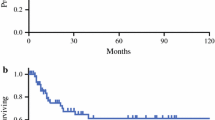Abstract
Background
In advanced gastric cancer (AGC) with duodenum invasion, the posterior pancreatic lymph nodes are susceptible to metastasis because of their proximity to the duodenum. The therapeutic value of lymph node dissection in this area for AGC with macroscopic duodenum invasion remains unclear.
Methods
Patients who had undergone curative gastrectomy for lower-third AGC from 1970 to 2004 at the Cancer Institute Hospital were recruited for this study. Clinicopathological data were collected retrospectively, and compared between cases of AGC with duodenum invasion (AGC-DI group) and AGC without duodenum invasion (AGC-nDI group). In the AGC-DI group, the therapeutic value of lymph node dissection was evaluated using a therapeutic index (multiplication of the frequency of metastasis to the station by the 5-year survival rate of patients with metastasis to that station).
Results
The AGC-DI group generally had tumors of higher pathological stage, which might account for the poorer 5-year survival rate compared with that of the AGC-nDI group (50.1% versus 68.5%; P = 0.0002). The incidence of lymph node metastasis was higher in the AGC-DI group than that in the AGC-nDI group, including nodes in the posterior pancreatic head (23.9% versus 7.0%, P < 0.0001). In the AGC-DI group, posterior pancreatic head lymph node dissection was of therapeutic value (4.19) equivalent to dissection of second-tier lymph nodes.
Conclusions
The dissection of posterior pancreatic head lymph nodes might be effective in AGC with macroscopic duodenum invasion since this has therapeutic value equivalent to that of second-tier lymph node dissection and might improve patients’ long-term outcomes.




Similar content being viewed by others
References
Hartgrink HH, van de Velde CJ, Putter H, Bonenkamp JJ, Klein Kranenbarg E, Songun I, et al. Extended lymph node dissection for gastric cancer: who may benefit? Final results of the randomized Dutch gastric cancer group trial. J Clin Oncol. 2004;22:2069–77.
Bonenkamp JJ, Songun I, Hermans J, Sasako M, Welvaart K, Plukker JT, et al. Randomised comparison of morbidity after D1 and D2 dissection for gastric cancer in 996 Dutch patients. Lancet. 1995;345:745–8.
Cuschieri A, Fayers P, Fielding J, Craven J, Bancewicz J, Joypaul V, et al. Postoperative morbidity and mortality after D1 and D2 resections for gastric cancer: preliminary results of the MRC randomised controlled surgical trial. The Surgical Cooperative Group. Lancet. 1996;347:995–9.
Cuschieri A, Weeden S, Fielding J, Bancewicz J, Craven J, Joypaul V, et al. Patient survival after D1 and D2 resections for gastric cancer: long-term results of the MRC randomized surgical trial. Surgical Co-operative Group. Br J Cancer. 1999;79:1522–30.
Kodera Y, Schwarz RE, Nakao A. Extended lymph node dissection in gastric carcinoma: where do we stand after the Dutch and British randomized trials? J Am Coll Surg. 2002;195:855–64.
Maruyama K, Okabayashi K, Kinoshita T. Progress in gastric cancer surgery in Japan and its limits of radicality. World J Surg. 1987;11:418–25.
Maruyama K, Sasako M, Kinoshita T, Sano T, Katai H. Can sentinel node biopsy indicate rational extent of lymphadenectomy in gastric cancer surgery? Fundamental and new information on lymph-node dissection. Langenbecks Arch Surg. 1999;384:149–57.
Nakajima T. Gastric cancer treatment guidelines in Japan. Gastric Cancer. 2002;5:1–5.
Japanese Gastric Cancer Association. Japanese classification of gastric carcinoma—2nd English edition. Gastric Cancer 1998;1:10–24.
Kakeji Y, Korenaga D, Baba H, Watanabe A, Tsujitani S, Maehara Y, et al. Surgical treatment of patients with gastric carcinoma and duodenal invasion. J Surg Oncol. 1995;59:215–9.
Kakeji Y, Tsujitani S, Baba H, Moriguchi S, Mori M, Maehara Y, et al. Clinicopathologic features and prognostic significance of duodenal invasion in patients with distal gastric carcinoma. Cancer. 1991;68:380–4.
Sasako M, McCulloch P, Kinoshita T, Maruyama K. New method to evaluate the therapeutic value of lymph node dissection for gastric cancer. Br J Surg. 1995;82:346–51.
Aiko T, Sasako M. The new Japanese classification of gastric carcinoma: points to be revised. Gastric Cancer. 1998;1:25–30.
Sasako M, Sano T, Katai H, et al. Radical surgery. In: Sugimura T, Sasako M, editors. Gastric cancer. Oxford: Oxford University Press; 1997. p. 223–48.
Castleman B. Extension of gastric carcinoma into the duodenum. Ann Surg. 1936;103:348–52.
Zinninger MM, Collins WT. Extension of carcinoma of the stomach into the duodenum and esophagus. Ann Surg. 1949;130:557–66.
Paramanandhan TL. The duodenal spread of gastric carcinoma. Br J Surg. 1967;54:169–74.
Perng DS, Jan CM, Wang WM, Chen LT, Liu CS, Huang TJ, et al. Clinicopathologic study of gastric carcinoma with duodenal invasion. Kaohsiung J Med Sci. 1996;12:461–5.
Sasako M, Sano T, Yamamoto S, Kurokawa Y, Nashimoto A, Kurita A, et al. D2 lymphadenectomy alone or with para-aortic nodal dissection for gastric cancer. N Engl J Med. 2008;359:453–62.
Wu CW, Hsiung CA, Lo SS, Hsieh MC, Chen JH, Li AF, et al. Nodal dissection for patients with gastric cancer: a randomized controlled trial. Lancet Oncol. 2006;7:309–15.
Author information
Authors and Affiliations
Corresponding author
Rights and permissions
About this article
Cite this article
Tokunaga, M., Ohyama, S., Hiki, N. et al. Therapeutic Value of Lymph Node Dissection in Advanced Gastric Cancer with Macroscopic Duodenum Invasion: Is the Posterior Pancreatic Head Lymph Node Dissection Beneficial?. Ann Surg Oncol 16, 1241–1246 (2009). https://doi.org/10.1245/s10434-009-0345-4
Received:
Revised:
Accepted:
Published:
Issue Date:
DOI: https://doi.org/10.1245/s10434-009-0345-4




